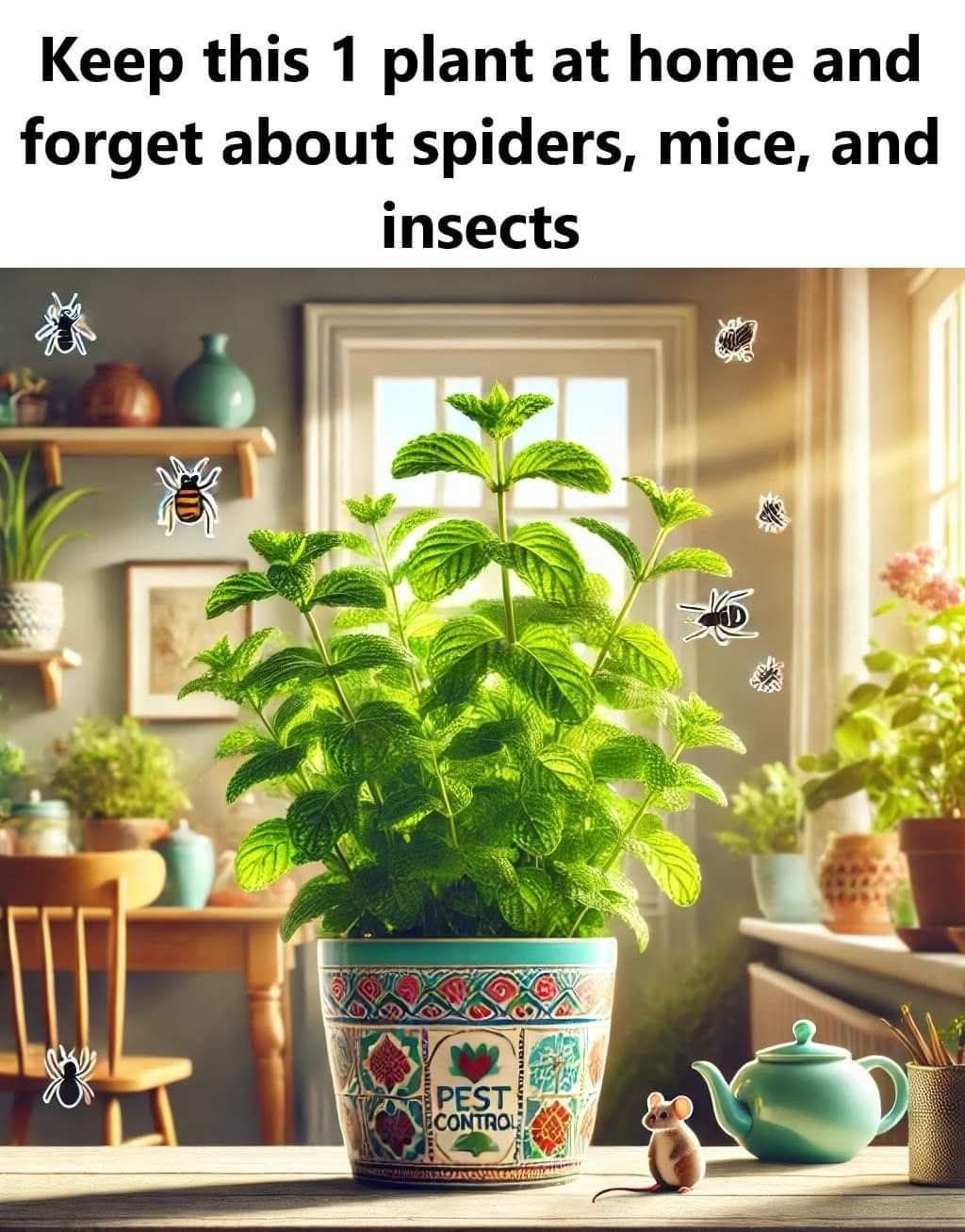Christine
In today’s world, where chemical pest control solutions are prevalent, many homeowners are seeking natural alternatives to keep their homes free of unwanted pests. Natural pest control methods not only help maintain a healthy living environment but also contribute to ecological balance. One such method involves using specific plants known for their pest-repelling properties. These plants offer a safe, eco-friendly, and aesthetically pleasing way to manage pests in the home.
The Miracle Plant: An Overview
The plant that stands out for its remarkable ability to repel spiders, mice, and insects is the peppermint plant (Mentha piperita). Known for its strong, refreshing aroma, peppermint is a hardy perennial herb that belongs to the mint family. Its vibrant green leaves and delightful scent make it a popular choice for both culinary and medicinal purposes. However, its pest-repelling properties truly set it apart as a must-have plant for any household.
Peppermint has long been known for its versatility and range of health benefits, including its ability to calm an upset stomach and relieve headaches. It’s also highly effective when used as a pest repellent in homes, providing an excellent alternative to harmful chemical solutions. For those seeking a more holistic approach to pest control, peppermint can offer a solution that is as effective as it is natural.
How This Plant Repels Spiders
Spiders are highly sensitive to strong scents, and peppermint’s potent aroma is particularly offensive to them. The menthol content in peppermint oil acts as a natural deterrent for spiders, overwhelming their sense of smell and disrupting their ability to detect prey. By placing peppermint plants around the house, especially in corners and near windows, you create an environment that spiders find inhospitable, effectively keeping them at bay.
The strong menthol smell from peppermint confuses spiders and inhibits their ability to locate their food sources or potential breeding sites. Spiders are territorial creatures and will avoid areas where they sense danger. This natural form of pest control allows you to protect your home from spider infestations without resorting to toxic chemicals that can be harmful to humans and pets.
Keeping Mice Away with Natural Scents
Mice rely heavily on their sense of smell to navigate and find food. The strong scent of peppermint is overwhelming to mice, making it an excellent natural repellent. When peppermint plants are strategically placed around the home, especially near entry points and in areas where mice are commonly found, the scent acts as a barrier that mice are reluctant to cross. This natural method of pest control is safe for households with pets and children.
Mice, like many pests, are driven by their sense of smell to find food and shelter. By using peppermint, homeowners can effectively block their access to specific areas of the home. Mice are known to avoid places where they detect strong smells such as peppermint, cinnamon, or even eucalyptus, which are all common natural repellents. Additionally, peppermint plants are easy to maintain and can be a long-lasting solution to prevent mouse infestations.
This natural approach to pest control provides a sustainable solution, allowing homeowners to manage mouse populations without having to rely on toxic baits, traps, or chemicals. It also helps avoid the environmental damage caused by commercial rodenticides.
Insect-Repellent Properties of the Plant
Peppermint’s insect-repelling properties are well-documented, with its essential oils being used in various natural insect repellent products. The menthol in peppermint oil is effective against a wide range of insects, including ants, mosquitoes, and flies. By having peppermint plants indoors, you can reduce the presence of these pests naturally. The plant’s aroma confuses and deters insects, making it difficult for them to locate food sources or breeding grounds.
Essential oils derived from peppermint are widely used in commercial insect repellent sprays and candles. The cooling effect of menthol is believed to confuse the sensory receptors of insects, making it difficult for them to detect and locate potential food sources. Mosquitoes, which rely on chemical cues such as carbon dioxide and body odors to locate their hosts, are less likely to approach areas where peppermint is growing. Similarly, ants and flies find it difficult to navigate in areas where peppermint is present.
Many gardeners and homeowners alike use peppermint plants in their gardens or indoors to create natural pest barriers. The use of peppermint as a natural insecticide avoids the harmful chemicals found in many traditional insect sprays, which can be harmful to pets, children, and the environment.
Scientific Explanation of the Plant’s Efficacy
The effectiveness of peppermint as a pest repellent is largely due to its high menthol content. Menthol is a natural compound that interferes with the sensory receptors of pests, making it difficult for them to process environmental cues. Studies have shown that menthol can disrupt the neurological pathways of insects, leading to disorientation and avoidance behavior. This scientific basis underpins the widespread use of peppermint in natural pest control strategies.
Peppermint’s essential oil contains compounds such as menthone and menthol, which not only have medicinal properties but also play a vital role in pest deterrence. Insects, spiders, and rodents have highly developed olfactory systems, and peppermint’s strong fragrance overwhelms their sense of smell, leading to avoidance. The impact of menthol on insect behavior has been the subject of several studies, with results consistently showing that it reduces the likelihood of pest activity in areas treated with peppermint.
How to Care for the Plant at Home
Caring for a peppermint plant is relatively easy, making it an ideal choice for both novice and experienced gardeners. Peppermint thrives in well-drained soil and requires regular watering to keep the soil moist but not waterlogged. It prefers partial to full sunlight and can be grown indoors in pots or containers. Regular pruning helps maintain the plant’s shape and encourages bushier growth, enhancing its pest-repelling capabilities.
Peppermint plants can be grown in a variety of conditions, and they are known to be quite resilient. They can thrive both indoors and outdoors, although it is important to keep in mind that peppermint is an aggressive grower. To prevent it from overtaking your garden or home, it is best to keep it in a container or to regularly prune the plant. Pruning not only helps maintain its shape but also ensures that the plant continues to grow vigorously, which directly contributes to its ability to repel pests effectively.
Peppermint also benefits from a moderate amount of nutrients, so using a balanced fertilizer can help boost its growth. It is worth noting that peppermint is a fast-growing herb, so it will need to be repotted periodically to ensure its roots have enough space.
Ideal Placement for Maximum Effectiveness
For maximum pest-repelling effectiveness, place peppermint plants in strategic locations around your home. Consider areas where pests are most likely to enter, such as near doors, windows, and vents. Additionally, placing plants in corners and dark areas where spiders tend to congregate can help keep these pests away. By distributing peppermint plants throughout your living space, you create a natural barrier that deters a variety of pests.
The best placement for peppermint plants indoors includes areas that receive adequate sunlight and ventilation. Kitchen windowsills, bathroom corners, and even near entryways can be effective spots for peppermint to work its magic. Outdoors, peppermint can be planted along the perimeter of your garden or near outdoor seating areas to keep insects at bay during warmer months.
If you’re not able to plant peppermint directly in the ground, consider placing pots with peppermint plants in these locations. This flexibility makes peppermint an ideal choice for both indoor and outdoor spaces.
Additional Benefits of Having the Plant Indoors
Beyond its pest-repelling properties, peppermint offers several additional benefits when kept indoors. Its refreshing scent can improve air quality and provide a natural aroma that invigorates the senses. Peppermint is also known for its therapeutic properties, such as reducing stress and enhancing focus. Furthermore, having greenery indoors contributes to a calming and aesthetically pleasing environment, promoting overall well-being.
The presence of plants indoors has been shown to improve air quality by absorbing carbon dioxide and releasing oxygen. Peppermint, in particular, is a great choice for improving the air quality in your home because it is known for its ability to purify indoor air. Additionally, peppermint is often used in aromatherapy for its stress-relieving properties. The invigorating scent can help alleviate headaches, improve focus, and promote mental clarity.
Incorporating plants like peppermint into your home decor not only provides natural pest control but also enhances the aesthetic appeal of your space. The vibrant green leaves of the peppermint plant add a refreshing touch of nature to any room.
Conclusion: A Natural Solution for a Pest-Free Home
Incorporating peppermint plants into your home is a simple yet effective way to achieve natural pest control. With its ability to repel spiders, mice, and a variety of insects, peppermint provides a safe and eco-friendly alternative to chemical solutions. By caring for this versatile plant and strategically placing it around your home, you can enjoy a pest-free environment while reaping the additional benefits of improved air quality and a soothing atmosphere. Embrace the power of nature and let peppermint transform your living space into a sanctuary free from unwanted pests.
Peppermint offers a holistic, environmentally friendly solution for pest control, making it a valuable addition to any home. Whether you’re looking to reduce your reliance on chemicals or simply want a more natural way to manage pests, peppermint plants provide a simple, effective, and beautiful solution that works. Let peppermint be your partner in creating a pest-free, healthier, and more enjoyable living space.





